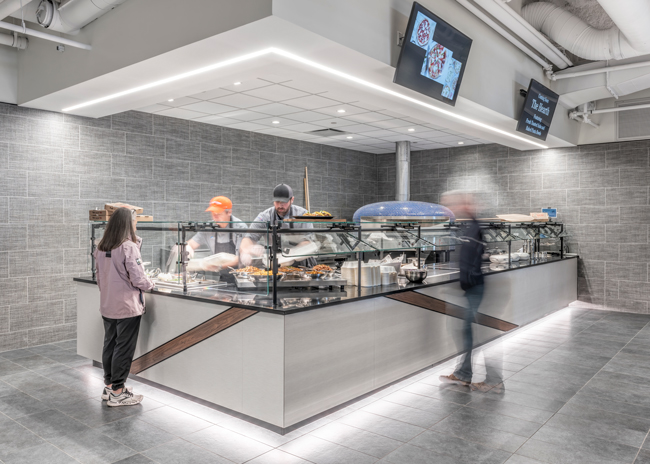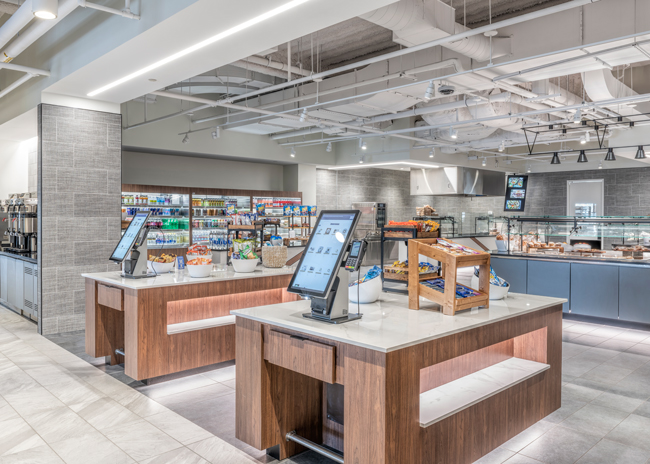Industry trends and issues as seen through the eyes of those who specify kitchen equipment
 Laura Lentz, design principal, Culinary AdvisorsListen up, world: Specifiers are speaking about what’s in store for the industry next year. “We have seen so many changes these past two years, and we’re all still getting a handle on them,” says Laura Lentz, design principal at Culinary Advisors. “There are no clear answers, but in working together and brainstorming, we’re figuring out what we can do now to tackle these issues.”
Laura Lentz, design principal, Culinary AdvisorsListen up, world: Specifiers are speaking about what’s in store for the industry next year. “We have seen so many changes these past two years, and we’re all still getting a handle on them,” says Laura Lentz, design principal at Culinary Advisors. “There are no clear answers, but in working together and brainstorming, we’re figuring out what we can do now to tackle these issues.”
One eye-opening point from Lentz: “Equipment doesn’t have to last 20 years anymore; that mindset has changed.” That’s not the only mindset that has changed. Specifiers have been noting a slew of trends impacting the industry. Here, several share their thoughts on trends from the point of view of specifiers.
POV: Labor and Automation
“The No. 1 issue — as far as design goes — is labor,” Lentz says. “Labor shortages are top of mind right now. More people are back in the office. The restaurant and hospitality scene is very active right now.”
Labor goes hand in hand with technology, both in the back of the house and at the front. Everything is on the table these days, including from online/remote ordering apps, smart equipment, robots and better integration helping to streamline operations. “Technology has grown by leaps and bounds so quickly that it’s no longer an afterthought in the design process — it’s one of the first considerations in the process,” Lentz says.
 Ryan Mikita, principal, Ricca Design StudiosIncorporating technology-based solutions like app ordering or connected equipment, continues to face some hurdles across all operator segments, including noncommercial segments such as healthcare foodservice. “Foodservice is sometimes on the same IT network as patient information. Operators have to figure out how to launch their foodservice program that doesn’t jeopardize the security of the health system,” Lentz says, who notes it’s a constant learning curve for consultants.
Ryan Mikita, principal, Ricca Design StudiosIncorporating technology-based solutions like app ordering or connected equipment, continues to face some hurdles across all operator segments, including noncommercial segments such as healthcare foodservice. “Foodservice is sometimes on the same IT network as patient information. Operators have to figure out how to launch their foodservice program that doesn’t jeopardize the security of the health system,” Lentz says, who notes it’s a constant learning curve for consultants.
On the subject of automation, Lentz says, “We’re not necessarily specifying robots all the time, but the need for them is growing and we’re definitely looking for more automated solutions.”
Notable: The Electrification of Kitchens
“The biggest trend for the future, in my opinion, is electrification of kitchens — it’s becoming a conversation in almost every sector,” says Ryan Mikita, principal at Ricca Design Studios, who notes the trend has moved beyond California. He notes that some hospitality and healthcare clients now have initiatives to go net zero carbon or shift to all-electric equipment with new facilities.
Mikita has one healthcare client that wants all of its new facilities to be 100% electric. “There’s more induction equipment cooking out front, which is nothing new, but now instead of having to put hoods on the front counter, we’re seeing more equipment solutions with less infrastructure requirements overall,” he says. One of the reasons he believes ventless equipment continues to grow in popularity is due to the added flexibility it offers, where operators can move equipment around and create mini kitchens where they didn’t exist prior.
Supply Chain Ambition
 Joe Sorgent, senior consultant and director of sustainability, Cini-Little International Inc.While foodservice designers see some improvement in the lead times associated with getting equipment, there are still plenty of delays, and that’s impacting their work. “We have had to do a lot more research earlier in the design process to confirm what equipment is available,” says Joe Sorgent, senior consultant and director of sustainability at Cini-Little International Inc. “We’re not necessarily specifying temporary pieces, but we’re definitely making choices based on delivery schedules and go with a manufacturer we might not normally choose in that situation.”
Joe Sorgent, senior consultant and director of sustainability, Cini-Little International Inc.While foodservice designers see some improvement in the lead times associated with getting equipment, there are still plenty of delays, and that’s impacting their work. “We have had to do a lot more research earlier in the design process to confirm what equipment is available,” says Joe Sorgent, senior consultant and director of sustainability at Cini-Little International Inc. “We’re not necessarily specifying temporary pieces, but we’re definitely making choices based on delivery schedules and go with a manufacturer we might not normally choose in that situation.”
Jill Anderson, senior project manager at Rippe Associates, says she’s seen significant equipment delays from as much as several weeks or months to even a year at one point. The best way to tackle these ongoing supply issues “is to get the consultant on board earlier so they can procure the equipment sooner,” she says, noting that she’s also worked with dealers that have larger, more stocked warehouses to source pieces she needs while keeping prices down.
Mikita takes a straightforward approach to handling supply chain problems. “No sugar coating. We have to be upfront with the client on day one in terms of setting the construction schedule and have a hard discussion on what that means from a design standpoint,” he says. “We have to make sure all the decision makers are present early and readily available and keep in close contact with the manufacturers along the way. There’s definitely been more flexibility from clients who used to be really interested in one supplier versus another.”
Customer Convenience
 Jill Anderson, senior project manager, Rippe AssociatesSimply put, the to-go, prepay, online ordering, text-when-ready-for-pickup apps and technologies that consumers became used to during the pandemic make people not want to wait in lines anymore. “We learned that we don’t need to wait in line anymore,” Lentz says, noting that online ordering and a simple text notification when food is ready creates that convenience consumers today crave. “That’s a huge shift in all of our minds. Why shouldn’t I be able to preorder my food, put my stuff down at a table, get a drink and simply pick it up when it’s ready?”
Jill Anderson, senior project manager, Rippe AssociatesSimply put, the to-go, prepay, online ordering, text-when-ready-for-pickup apps and technologies that consumers became used to during the pandemic make people not want to wait in lines anymore. “We learned that we don’t need to wait in line anymore,” Lentz says, noting that online ordering and a simple text notification when food is ready creates that convenience consumers today crave. “That’s a huge shift in all of our minds. Why shouldn’t I be able to preorder my food, put my stuff down at a table, get a drink and simply pick it up when it’s ready?”
Sorgent says he’s seeing growth (or at least increased interest) in the use of food lockers or — at a minimum — cubbies or shelves for to-go orders. And while one might think that the increase in off-site food might move designers to design separate or multiple cooklines, that’s actually not always the case. Rather, advancements in integrated ordering and kitchen display technology have streamlined processes.
“Instead of tickets, everything is going digital at the back of the house, with all the orders going through the same place,” he says. Instead of separate cooklines, at least at the healthcare level, Sorgent says he’s seeing “pod” systems gaining traction, where you may have a traditional cookline for all the orders but have staff in different areas finishing the orders — boxing up to-go orders or plating food on trays.
Anderson points to the growth of Amazon’s Just Walk Out technology as part of this yearn for convenience, where customers can simply walk into a market, grab what they want and walk out the door without even reaching for their wallets. “We are working with several clients who want to use this technology for grab-and-go spaces we are planning,” she says.
Flexibility
The term “flexibility” gets tossed about frequently when discussing what operators want from their designs, but what does that really mean? “It means ventless equipment to me, and fortunately, this equipment has grown by leaps and bounds over the years,” says Lentz. It’s the plug-and-play, pop-up capability without the need for black iron that Lentz says is the biggest draw for her when it comes to looking for flexibility. With ventless, it’s possible to cook just about anywhere outside of a main kitchen — be it a lobby, dormitory, atrium, airport, food hall or other nontraditional venue.
Aside from multiuse equipment like combis and rapid-cook ovens, another way to introduce flexibility is through what Lentz describes as “method-based” design. “The need to design a station around a piece of equipment I think will fade away,” she says. When it comes to flexibility, she sees more of an assembly line setup, where foods like pasta are cooked halfway and then finished, tossed, rewarmed and/or assembled in front of the customer.
Interchangeable hot/cold/frozen wells, or even countertops or slabs of stone with heating and cooling capabilities coming from underneath, not only allow operators to display more types of food side by side, they also hold temperature more efficiently and support self-service options.
The Changing Role of the Foodservice Designer
Whereas supply chain challenges have pushed foodservice designers into planning conversations earlier, faster deadlines and higher aspirations are causing consultants to have to do more “due diligence than ever before to make sure we’re aware of and more knowledgeable about various solutions,” Mikita says. “On the design side, we have to get more creative and be more resourceful and rely on manufacturers’ reps to provide us with utility requirements, a cut sheet and information on technologies. We have to establish equipment lists and schedules earlier in the design process to hone in on these requirements.”
The emphasis on 3D rendering and even virtual reality as part of the design process continues to gain prominence. “We’re at a point where we provide headsets for clients to allow them to tour projects seemingly in person,” Mikita says. “We can meet with clients in a board room, give them a VR headset, and they can walk through the space while we project it on screen for everyone else in the room. There’s a huge emphasis on showcasing all the details of the concept and getting the operator to really understand what is being planned so there are no surprises.”
Specification writing has also become much more critical, and “all details now are very important because equipment can be specified in so many ways,” says Mikita, noting the growth of accessories like Wi-Fi connectivity and other technologies. “Specs are getting longer as there is more customization.”
 While technology continues to impact just about every aspect of the industry, one industry trend with staying power is transparency, as seen in this healthcare design developed by Cini-Little International. Guests have clear views of all the food at this station, including the pizza oven toward the back. Photo courtesy of Cini-Little International and Richard Gaylep Photography.
While technology continues to impact just about every aspect of the industry, one industry trend with staying power is transparency, as seen in this healthcare design developed by Cini-Little International. Guests have clear views of all the food at this station, including the pizza oven toward the back. Photo courtesy of Cini-Little International and Richard Gaylep Photography.
Quick Take
Healthcare
Patient meal delivery models and systems: “Most [healthcare foodservice operators] are going for either room service or a la carte service versus batch delivery,” says Joe Sorgent, Cini-Little International Inc.
Better-than-ever food: Healthcare foodservice operators today are “going for an extremely competitive level of high-quality food,” says Ryan Mikita, Ricca Design Studios. So much so that Mikita says some are making a point of community engagement to attract people off the streets and not just feed patients, visitors and staff. “They’re even relocating [serveries] closer to lobbies and street-level entrances,” he adds. “This is a huge cultural transition for the segment. Healthcare kitchens are starting to look like traditional hospitality kitchens.”
Staff meal delivery: “Most hospital staff only have 30 minutes at the most to pick up and eat their food so [healthcare foodservice operators] are exploring food lockers, third-party ordering and delivery, with runners delivering food around a campus,” says Sorgent.
Market-style concepts: “The convenience factor is growing; I’m seeing more clients want 24/7 specialty markets and even high-end vending — pieces that make their own soup, ice cream and salads,” says Sorgent.
Colleges & Universities
Demo stations: “I’m seeing more clients interested in separate stations that can be used for cooking demos, special parties and catering,” says Sorgent.
100% electric kitchens: Mikita has been pointing out the growth of electrification for a while now, noting that new-build projects at college and universities are including more electric equipment.
New seating arrangements: Jill Anderson, senior project manager, Rippe Associates, says she’s been seeing more universities shift back to larger areas per seat with a mix of small group areas and more singles and counters to be able to work independently.
Market-style outlets: While “there’s not really much of a desire to move away from a self-serve model in the servery, contrary to what people thought during the pandemic, [university foodservice operators] are still looking to offer multiple touch points with retail venues across campus in case students don’t have time or don’t want to go to the servery,” says Mikita. “But those need to be equitable experiences in that the same offerings from the servery are available in a prepackaged way. I’m even seeing retail hubs set close or adjacent to serving areas like a market-style staged with a grocery store component to them.”
Casinos
Buffet replacements: The pandemic quickly shut down buffets at many casinos. “Some operators are not wanting to reopen them, and they replace them with a food hall instead,” says Jill Anderson, senior project manager, Rippe Associates.
Modified ordering: Some casino operators use advanced ordering solutions that will text customers when their food is ready for pickup. Most casinos continue to struggle to find food runners to deliver food directly to guests, says Anderson.
Semi-prepared food: Casinos are “keeping some of the same basic themes, like seafood and carving stations, but they’re cooking more food in bulk so customers are still seeing the action but not everything is made-to-order,” says Anderson.
 Photo courtesy of Cini-Little International and Richard Gaylep Photography.
Photo courtesy of Cini-Little International and Richard Gaylep Photography.
What’s In, What’s Out
Kip Serfozo, FCSI, LEED ID&C AP, WELL AP, design director at Cini-Little International Inc., shares his perspective about what’s in and what’s on its way out for the next year in terms of design and equipment trends.
What’s In
Fully insulated equipment: “These pieces keep heat out of the kitchen and reduce noise levels to create better working environments.”
Electric equipment: “I’ve been designing more electric kitchens and specifying more electric kitchen equipment. [Electric equipment pieces] have a lot of advantages — they are very clean, don’t emit harmful gases that can be inhaled and lessen the impact on the environment.”
Full-scale water filtration: “Water is the next frontier — after all, it’s a food product and consumers are getting more concerned about quality.”
Connected equipment: “Pieces that connect to the building system and that can be monitored and measured will be a must in new and remodeled kitchens.”
Better food waste solutions: “[One manufacturer] makes a dishwasher with a vacuum that sucks food waste into a compact container, extracts the water and makes it ready for composting. I see more clients exploring cutting-edge food waste solutions like this in the future.”
What’s Out
Solid fuel: “I know wood-fired cooking and coal-fired ovens are all the rage, but they spew so many harmful gases into the air that I wonder why chefs aren’t revolting more; as much as people like that flavor profile, I think those days are numbered unless manufacturers find a way to better insulate those pieces.”
Gas: “Any kitchen that operates with gas equipment has the potential to offset a lot of carbon and nitrogen dioxide into the air.”
Noisy equipment: “The dish room is often the noisiest area. Pulpers, grinders and exhaust hoods can also give off a lot of noise. I’m seeing more manufacturers [innovate] with decibel levels in mind, and more operators are choosing remote condensers for refrigeration and ice machines. Any equipment that can reduce the decibel levels is great.”



